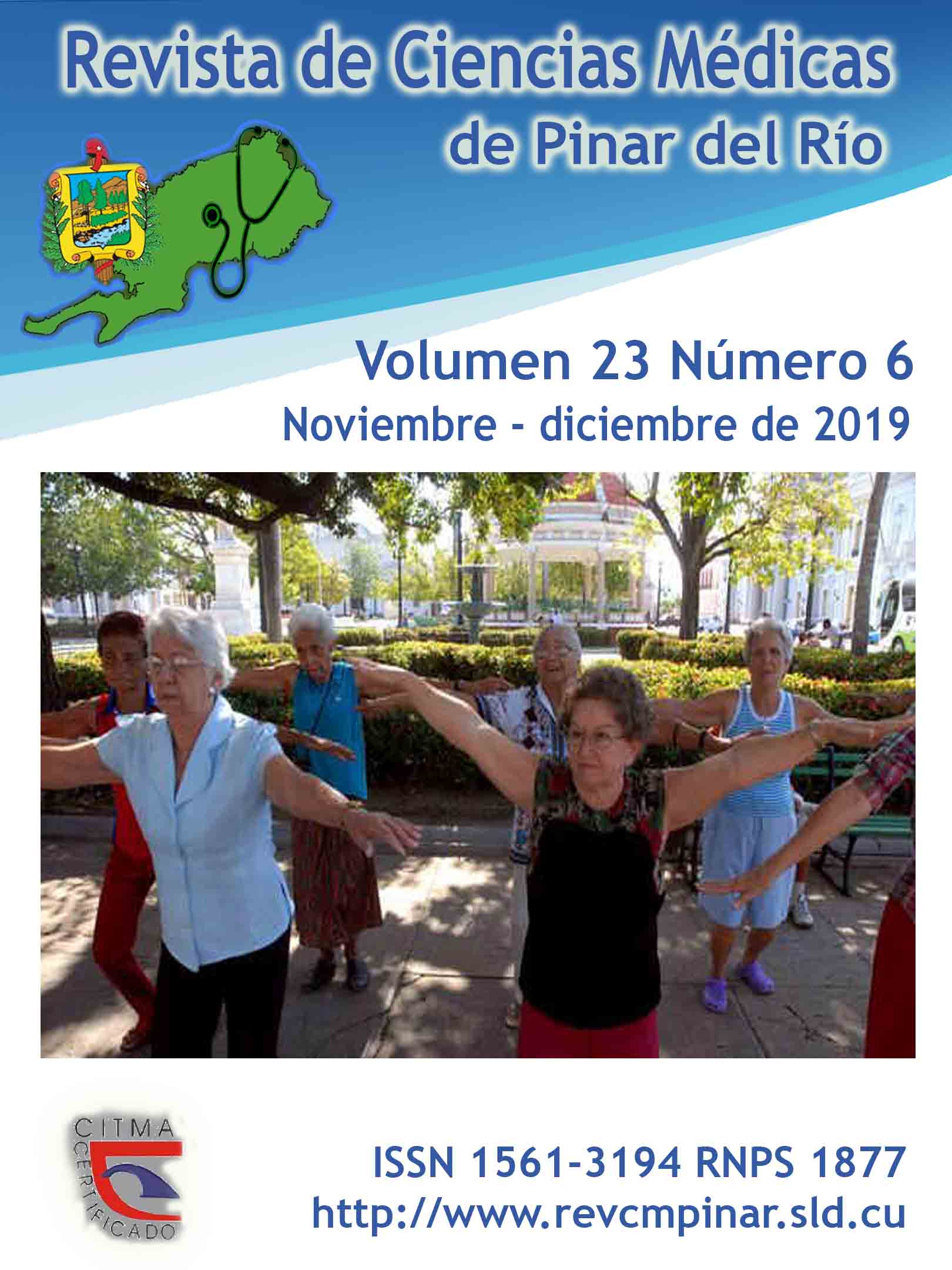Risk factors for cerebrovascular disease in older adults from a family doctor's office
Keywords:
DISEASE, RISK FACTORS, DIABETES MELLITUS, SMOKING, AGED.Abstract
Introduction: cerebrovascular diseases constitute a global health problem due to their high mortality and degree of physical and mental disability, the behavior of their risk factors in a health area is presented.
Objective: to identify the risk factors for cerebrovascular diseases in older adults in the 47th Doctor’s Office at Hermanos Cruz University Polyclinic, Pinar del Río during the year 2018.
Methods: a descriptive and cross-sectional observational study, the target group was compromised of 144 older adults, the simple random sample included 130 patients according to the inclusion criteria, and the variables were obtained through individual clinical histories and a survey.
Results: the sixth decade of life and male gender prevailed, the most frequent risk factors for cerebrovascular diseases were sedentary lifestyles, hypertension, smoking habit and diabetes mellitus, the association of two or three risk factors was recurrent and the most frequent association was hypertension, sedentary lifestyles and smoking habit.
Conclusions: cerebrovascular diseases in the population studied confirmed an epidemiological behavior according to current trends in Cuba and the world, which will allow drawing preventive and health-giving education strategies to promote lifestyles.
Downloads
References
1. Organización Mundial de la salud (OMS). Estadísticas Sanitarias Mundiales 2012. [Internet] OMS; 2013 [citado 30/01/2017]. Disponible en: http://apps.who.int/iris/bitstream/10665/82062/1/WHO_HIS_HSI_13.1_spa.pdf
2. Harrison. Principios de Medicina Interna. 18a ed. McGraw-Hill Interamericana Editores, S. A; 2012. p. 1992-97.
3. Álvarez Sintes R. Medicina General Integral. 3a ed. La Habana: Editorial Ciencias Médicas; 2014.p. 1571-90.
4. Mussenden Osvaldo E. Diagnóstico clínico de la enfermedad cerebrovascular extracraneal. Rev Cubana AngiolCirVasc. [Internet]. 2014 Dic [citado 02/06/2016]; 15(2): [aprox. 11p.]. Disponible en: http://scieloprueba.sld.cu/scielo.php?script=sci_arttext&pid=S1682-00372014000200005&lng=es.
5. Sacco RL, Asner SE, Broderick JP, Caplan LR, Connors JJ , Culebras A, et al. An updated definition of stroke for the 21st Century. A statement for healthcare professionals from the American Heart Association/ American Stroke Association (AHA/ASA) Expert Consensus Document. Stroke. [Internet] 2013 [cited 18/07/2015]; 44(7): [aprox. 20p.]. Available from: http://stroke.ahajournals.org/content/44/7 /2064.abstract.html
6. Escobar Alfonso V, Zaldivar Garit M, Rodríguez de la Rosa G, Cabrera Cordovés JC. Factores de riesgos prevalentes en pacientes ingresados por enfermedad cerebrovascular. RevCub Med Mil [Internet]. 2014 Dic [citado 02/06/2016]; 43(4): [aprox. 7p.]. Disponible en: http://scieloprueba.sld.cu/scielo.php?script=sci_arttext&pid=S0138-65572014000400003&lng=es.
7. Puentes Madera IC. Epidemiología de las enfermedades cerebrovasculares de origen extracraneal. Rev Cubana AngiolCirVasc. [Internet]. 2014 Dic [citado 02/06/2016]; 15(2): [aprox. 8p.]. Disponible en: http://scieloprueba.sld.cu/scielo.php?script=sci_arttext&pid=S1682-00372014000200002&lng=es.
8. López-Cancio Martínez E. Aterosclerosis intracraneal asintomática: prevalencia, factores clínicos y biomarcadores asociados [Tesis]. Barcelona: Universitat Autónoma de Barcelona, Departamento de Medicina; 2017.
9. Maniecka-Bryla I, Pikala M, Bryla M. Life years lost due to cardiovascular diseases. Kardiol Pol. [Internet]. 2013 [citado 02/06/2016]; 71(10): [aprox. 7p.]. Disponible en: https://www.ncbi.nlm.nih.gov/pubmed/24197588
10. Moreno VP, García-Raso A, García Bueno MJ, et al. Factores de riesgo vascular en pacientes con ICTUS isquémico. Distribución según edad, sexo y subtipo de ICTUS. RevNeurol. [Internet]. 2008 [citado 02/06/2016]; 46(10): [aprox. 5p.]. Disponible en: https://www.neurologia.com/articulo/2007646
11. González González A, Campillo Motilva R. Morbi-mortalidad por enfermedad cerebrovascular de tipo isquémica. Rev Cubana Med Gen Integr [Internet] 2007 [citado 02/02/2016]; 23(4). Disponible en: http://scielo.sld.cu/pdf/mgi/v23n4/mgi03407.pdf
12. Morales González HA, Blanco Aspiazu MÁ, Morales Morales EJ. Caracterización de factores de riesgo en sobrevivientes a un primer ictus isquémico en un área de salud. Revhabanciencméd [Internet]. 2009 Dic [citado 02/06/2016]; 8(5 Suppl5). Disponible en: http://scieloprueba.sld.cu/scielo.php?script=sci_arttext&pid=S1729-519X2009000500007&lng=es.
13. Mesa Cabrera M, Fábrega Valdés A, Blanco Aspiazu M, Morera Méndez F, Suárez Rivero B, Oliva Torres L, et al. Recurrencia del ICTUS cerebrovascular isquémico y su relación con algunos factores de riesgo. Rev Cub Med Mil [Internet]. 2006 [citado 20/02/2016]; 35(1). Disponible en: http://scielo.sld.cu/scielo.php?script=sci_arttext&pid=S0138 65572006000100006&lng=es
14. Mannami T, Iso. H, Baba H, et al. Cigarette Smoking and Risk of Stroke and its Subtypes among Middle-Aged Japanese Men and Women. The JPHC Study Cohort I. Stroke. [Internet]. 2004 [citado 20/02/2016]; 35(6): [aprox. 4p.]. Disponible en: https://www.ahajournals.org/doi/full/10.1161/01.str.0000128794.30660.e8
15. Fernández González B, Tárano Bonachea D, Arteaga Águila M, Rodríguez Mutuberría L. Influencia del antecedente de diabetes mellitus sobre la severidad del ictus en pacientes hipertensos. Rev cubana med [Internet]. 2013 Sep. [citado 02/06/2016]; 52(3): [aprox. 7p.]. Disponible en: http://scieloprueba.sld.cu/scielo.php?script=sci_arttext&pid=S0034-75232013000300005&lng=es
Published
How to Cite
Issue
Section
License
Authors who have publications with this journal agree to the following terms: Authors will retain their copyrights and grant the journal the right of first publication of their work, which will be publication of their work, which will be simultaneously subject to the Creative Commons Attribution License (CC-BY-NC 4.0) that allows third parties to share the work as long as its author and first publication in this journal are indicated.
Authors may adopt other non-exclusive license agreements for distribution of the published version of the work (e.g.: deposit it in an institutional telematic archive or publish it in a volume). Likewise, and according to the recommendations of the Medical Sciences Editorial (ECIMED), authors must declare in each article their contribution according to the CRediT taxonomy (contributor roles). This taxonomy includes 14 roles, which can be used to represent the tasks typically performed by contributors in scientific academic production. It should be consulted in monograph) whenever initial publication in this journal is indicated. Authors are allowed and encouraged to disseminate their work through the Internet (e.g., in institutional telematic archives or on their web page) before and during the submission process, which may produce interesting exchanges and increase citations of the published work. (See The effect of open access). https://casrai.org/credit/



